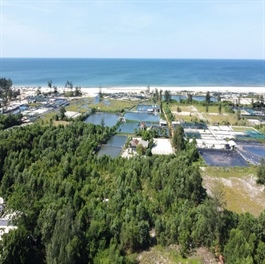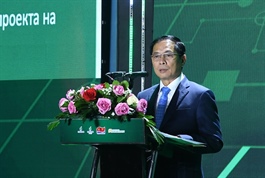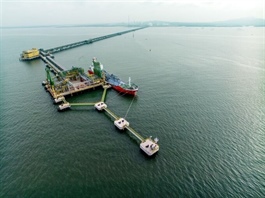Businesses navigating tariffs and industrial opportunity
Businesses navigating tariffs and industrial opportunity
With US tariff changes set to take effect, companies across Asia are undergoing a significant strategic shift. Dennis Yeo, head of Investor Services, Logistics, and Industrial at Cushman & Wakefield Asia-Pacific, explains how Vietnam can maintain its reform momentum and respond proactively to shifting global dynamics.
Amid rising trade tensions and the resurgence of economic nationalism, Vietnam is rapidly emerging as a key hub for firms aiming to reduce tariff exposure and enhance operational efficiency. This transformation goes beyond relocating production, it reflects a broader reconfiguration of the country’s industrial and logistics landscape.

Dennis Yeo, head of Investor Services, Logistics, and Industrial at Cushman & Wakefield Asia-Pacific |
The revised US tariff framework has prompted a wave of global business recalibration. Initially, Vietnam faced challenges when early drafts proposed a 46 per cent rate on its exports. However, after negotiations, the rate was reduced to 20 per cent, restoring investor confidence and reigniting momentum.
Tariffs are becoming a structural element of global trade. Rather than resisting them, companies are adapting by optimising supply chains to absorb these new costs.
Despite the added burden, businesses are beginning to treat tariffs as part of the new normal in an increasingly protectionist world. Companies will have no alternative but to accept tariffs as part of the cost and make their supply chain more efficient.
Following an initial pause, investment activity in Vietnam has resumed, particularly from smaller firms in the ASEAN region seeking new growth opportunities.
With over two decades of foreign direct investment in manufacturing, the nation offers a well-established industrial ecosystem. Its infrastructure, skilled labour force, and export-friendly policies provide a competitive edge over regional peers. Participation in multiple free trade agreements enhances market access, while ongoing administrative reforms improve the ease of doing business.
Standing out
For many multinational corporations, relocating operations to Southeast Asia has become essential. While expansion beyond their domestic market was already underway due to technological advancement and industrial maturity, tariff pressures have accelerated the shift.
Other economies in the region are also upgrading infrastructure and streamlining regulations to attract investment. However, Vietnam maintains a distinct advantage due to its low labour costs, favour access to major sea lanes, and stable economic environment.
According to our recent report 2025 Waypoint: Global Industrial Dynamics, which evaluated over 120 markets worldwide, Vietnam stands out as one of the few countries to rank among the most affordable markets globally for these key site selection factors. Although industrial rents in 2025 have increased by 70 per cent compared to 2019, actual costs remain highly attractive relative to regional peers. As of end 2024, average logistics real estate rents are approximately $5.30 per sq.m per month in Hanoi and $4.90 per sq.m per month in Ho Chi Minh City.
Logistics and manufacturing operations remain heavily reliant on human capital. A large, cost-effective labour force is a critical factor influencing site selection and operational strategy, from determining which processes to localise to the level of automation investment.
In Vietnam, labour costs are currently less than 25 per cent of the global median wage, placing the country among the most affordable labour markets in the Asia-Pacific region.
Meanwhile, electricity demand in modern logistics facilities is rising, driven by automation systems, smart management platforms, advanced material handling equipment, and the growing adoption of electric vehicles. As a result, operating costs are becoming an increasingly important consideration in decisions. Vietnam maintains its competitive edge, with industrial electricity prices among the lowest globally, only higher than Indonesia and Nigeria.
These advantages make the country particularly attractive to multinational corporations seeking to expand operations. The shift is no longer limited to final assembly, many firms are now considering full supply chain migration to capitalise on lower costs and policy stability, particularly in relation to transshipment tariffs.
One emerging opportunity lies in transshipment tax optimisation. Bonded warehouses and foreign trade zones allow goods to be stored without incurring tariffs until they enter the domestic market. These models offer flexibility and cost savings, especially for companies managing complex cross-border flows.
The most visible impact of this transformation is unfolding in the industrial real estate sector. Demand for industrial parks, logistics hubs, and warehouses is surging, particularly in key regions such as Ho Chi Minh City, Haiphong, Bac Ninh, and Binh Duong. This growth is being driven by the steady diversification of global supply chains.
Several milestones underscore Vietnam’s growing appeal during the 2018 trade war. One notable example is the launch of BW Industrial Development, a joint venture between global private equity firm Warburg Pincus and local developer Becamex IDC, which marked a turning point in the country’s industrial real estate landscape. This initiative significantly expanded the supply of ready-built factories and logistics infrastructure, signalling strong international confidence in Vietnam’s long-term potential.
That same year, the country continued to attract major global manufacturers. Samsung, for example, had already invested over $17 billion by 2018, establishing large-scale production facilities that became magnets for supporting industries. The presence of such industry leaders has helped elevate Vietnam’s position in global supply chains and encouraged a wave of follow-on investment. These developments align with the nation’s ambition to become a leading logistics and distribution hub in the region.
A decisive role
Further reinforcing this momentum, reports from Cushman & Wakefield and other consultancies confirm the country’s rising prominence in Southeast Asia’s industrial property market. The continued presence of global logistics firms and sustained foreign direct investment into industrial areas highlights the strength of this trajectory.
Today’s supply chains are no longer defined solely by physical assets. They are increasingly digital, data-driven, and automated. As more companies shift operations to Vietnam, they are also deploying advanced logistics technologies such as smart warehousing, reverse logistics systems, and AI-powered inventory management.
Tools like Internet of Things-enabled monitoring and cloud-based logistics platforms are helping businesses navigate trade volatility and improve operational performance. While adoption is still scaling, the presence of international firms is accelerating the country’s technological maturity.
One critical area is talent development. As supply chains become more automated and data-driven, demand for a digitally-skilled workforce will intensify. Investment in vocational training, STEM education, and industry-academia collaboration will be essential to meet the needs of advanced manufacturing and smart logistics operations.
At the same time, regulatory transparency and institutional efficiency will play a decisive role in shaping investor sentiment. Streamlined permitting processes, consistent enforcement of trade policies, and improved land-use planning can help reduce friction and accelerate project timelines.
Environmental sustainability will also become a competitive differentiator. As global corporations align with environmental, social, and governance commitments, Vietnam’s ability to offer green-certified industrial areas, renewable energy integration, and low-carbon logistics solutions will influence site selection decisions. Public-private partnerships in clean energy and circular economy initiatives could further enhance the country’s appeal.
To fully capitalise on the relocation wave, Vietnam must continue strengthening both its hardware and software foundations. This includes ongoing investment in multi-modal logistics infrastructure, integrating road, sea, air transport, and energy systems, as well as improvements in digital governance, vocational training, and administrative efficiency.
Digital transformation will underpin much of this progress. From blockchain-enabled customs clearance to AI-powered demand forecasting, the integration of smart technologies will be key to optimising performance and managing complexity. Government support for digital infrastructure and cybersecurity will be vital to ensure scalability and trust.
Long-term competitiveness will depend on reducing bureaucratic friction and enhancing the regulatory environment. Streamlined business processes and a skilled workforce will be essential to sustaining investor confidence and supporting a more sophisticated industrial ecosystem.
In the years ahead, Vietnam’s industrial real estate and logistics sectors are poised to evolve from cost-driven platforms into strategic enablers of global competitiveness. Success will hinge not only on physical assets, but on the country’s ability to deliver speed, reliability, sustainability, and innovation at scale.
- 09:49 19/08/2025























